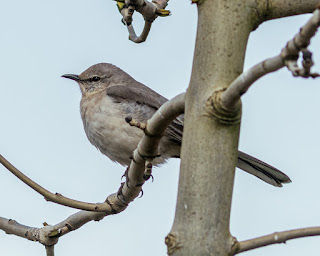After a long stay in Exmouth during the last lockdown, and a very brief appearance in Sussex, we had assumed that the Mockingbird had gone, and those of us that didn't want to, or couldn't travel at the time had missed a biggie. Of the four previous records, only two were accepted and they were a long time ago.
News came out at the end of last week that it had appeared again, this time in a back garden in Newbiggin Northumberland. A bit further to travel than Devon, but at least there was another opportunity, so we set of early yesterday and arrived on site just after 10am. Interestingly, parking was rather straightforward and it was only a few yards to the observing spot where we joined the small crowd. The Mockingbird was initially seen in a tangle of clematis on a fence top, largely hidden, and seemed to be feeding but after a short while it popped up onto a tree branch and gave stunning views, and seemed unperturbed ny the continuous machine gun of the DSLR shutters. It eventually dropped down again for a bit and then flew up to a TV arial. Having had our fill we returned to the car and then moved to the church point car park.
Offshore there was a constant stream of Arctic and Sandwich terns, some Kittiwakes and Eider ducks. One or two nice Greenland Wheatears were perched up on the rocks and chalets, and there were also some flocks of Sanderling and Oystercatchers on the rocks. Unfortunately I couldn't confidently pick out any Roseate Terns in the heat haze and the local Iceland Gull eluded us as well.
looking at what to do on the way back, we rejected a few sites in the north Pennines and thought about calling it at Bempton Cliffs but decided it was a bit of a detour, but there had been a report of a red Necked Phalarope on some old gravel pits in the Idle valley near Doncaster just off the A1. This proved to be an interesting area and seemed good for waders with lots of breeding Lapwing and Redshank, some Dunlins, three Greenshank and a Whimbrel. The one missing one was the Phalarope. Otherwise it was standard gravel pit fare of a mix of ducks, including some lingering Wigeon, a Black Headed Gull colony, Common Terns, plus two Arctic Terns on the deck and a variety of reed-bed species.






